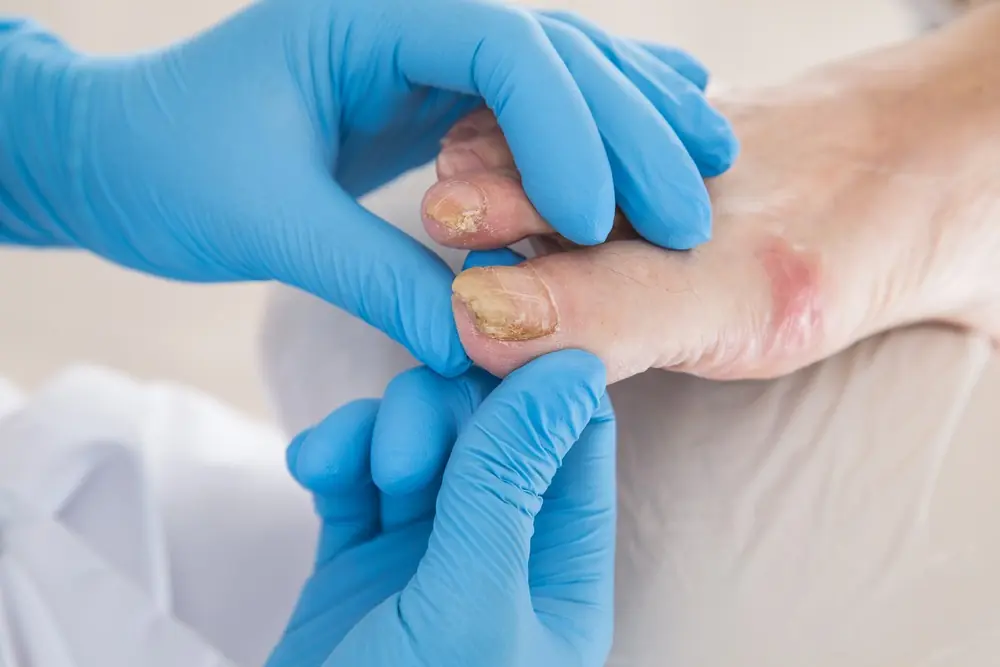
Nail culture consists of taking nail and skin fragments from under a nail that appears to be affected by a fungus.
The main purpose of this procedure is to rule out a diagnosis of various pathologies comparable to fungal toenail disease.
Examples include eczema or psoriasis, which may have similar symptoms but do not require the same treatment as onychomycosis.
Minimally invasive, nail culture has many benefits.
One of these is to facilitate the detection of a fungal foot infection that is difficult to treat if not treated early.
Learn how nail culture fits into the podiatrist’s arsenal of diagnostic tools and how it can help in selecting the right treatment for you.
The importance of detecting nail fungus
Some symptoms of nail fungus are similar to other skin infections such as psoriasis and eczema when left untreated.
The following symptoms are similar to those of nail fungus and are sometimes observed in patients with psoriasis or eczema:
- When the nail root is affected, irregularities such as grooves or punctured marks on the nail are visible.
- When the infection spreads to the nail bed, psoriasis can cause a change in colour to yellowish or orange shades.
- These skin diseases also sometimes lead to detachment (onycholysis) or a thickening of the underside of the nail (hyperkeratosis).
- Itching or discomfort
Although nail fungus is not systematically painful, it must be managed quickly to avoid complications.
A nail sample collected in a clinic will allow the podiatrist to make a clear diagnosis as to the source of the infection.
The podiatrist will also be able to prescribe the most appropriate treatment for the condition identified.
This may include nail fungus, psoriasis, eczema, athlete’s foot or an injury caused by shoes that are not adapted to the morphology of the foot.
Advantages of nail culture
In addition to the possibilities of extremely precise screening, the collection of nail culture samples makes it possible to scan for other potential pathologies.
This type of preventive treatment also has several other advantages:
- It causes very little or no pain.
- It takes very little time, about 20 minutes at most.
- It allows efficient and personalized management as soon as the results of the analysis are available (about 4 weeks).
This procedure is very important for those at higher risk of worsening foot infections.
Among the people at higher risk of developing a serious infection are:
- Diabetics
- Seniors
- People with immunodeficiency diseases like HIV
- People with weakened immune systems (in response to chemotherapy treatments for example)
In all cases, if your nails appear to have an infection, it is important to consult your podiatrist so that they can identify the exact nature of the infection.
Nail culture procedure
Several methods are used by the podiatrist to collect nail samples:
The first consists in scraping the nail with a scalpel over its entire thickness. The dander (thin slices of epidermis) collected by the podiatrist are then stored in a container or Petri dish.
The second method is similar to the first. The podiatrist scrapes the dorsal surface of the nail to collect deeper pieces of epidermis rather than more superficial samples, and cuts parts of your nail.
The third method of nail culture is performed by detaching a portion of the debris contained under the affected nail.
Before taking samples, the podiatrist carries out a preliminary examination to identify any lesions or plantar moulds that could affect the sample.
Your podiatrist then proceeds as follows:
Before treatment:
- The patient is placed in the position that provides the best access to the affected nail.
- The area to be treated is cleaned.
During treatment:
- Scraping is done according to the method deemed most appropriate by the podiatrist.
- Samples are stored in containers and sent to a specialized laboratory.
Following treatment:
- Samples from the nail culture are grown.
- Depending on the results, an appropriate therapeutic plan is proposed by the podiatrist.
Generally, the presence of a yeast is revealed within 48 hours of the start of incubation.
However, dermatophytes (fungi) may take longer to develop. This may be as long as four weeks.
Nail sampling: obtaining a diagnosis beyond any doubt
Once the pathology of the nail has been clearly identified, the podiatrist proposes treatment and provides care accordingly.
For nail fungus or athlete’s foot, a topical antifungal agent is preferred. Some cases require oral antifungals to be administered through their family doctor or a dermatologist.
For a pathology due to friction or irritation, the podiatrist can complement the treatment with plantar orthotics or foot care.
Does one of your toenails have a worrisome deformation or colour?
Do not hesitate to make an appointment with your podiatrist to put your mind at ease.